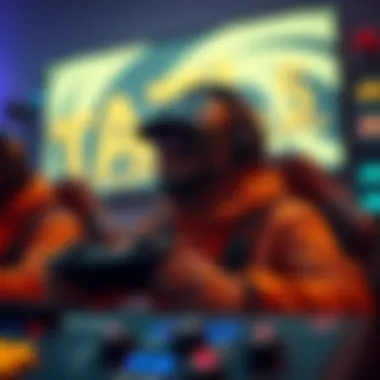Gala Play to Earn: Revolutionizing the Gaming Landscape


Intro
The world of gaming, traditionally a form of entertainment, is rapidly morphing into an economic powerhouse, where players are not just participants but also contributors to a burgeoning ecosystem. In particular, Gala Play to Earn stands out as a notable player in this sector, merging gaming with blockchain technology to create a space where players can earn tangible assets. This article aims to peel back the layers of the Gala platform, exploring its mechanics, implications, benefits, and hurdles associated with this innovative gameplay model.
Gala Games has made a significant impact on the industry, chiefly by integrating cryptocurrency into gaming. By enabling players to earn digital assets, it has reshaped perceptions around what it means to engage in gaming. No longer limited to high scores or achievements, players can now earn real monetary value through their experiences. In this guide, we'll meticulously dissect the elements at play and dig deeper into how these novel approaches add layers of complexity and opportunity within the gaming realm.
Understanding Cryptocurrency Fundamentals
To grasp the potential of Gala's play-to-earn model, a foundational understanding of cryptocurrency and blockchain technology is essential. These concepts underlie not just Gala but the future of many digital economies.
Key Concepts of Blockchain Technology
At its core, blockchain is a decentralized digital ledger that records transactions across many computers. Its key features include:
- Decentralization: No single entity controls the entire ledger; it is governed by consensus among all users.
- Immutability: Once entered, the data cannot be altered retroactively, enhancing trust and security.
- Transparency: All transactions are visible to anyone, which helps reduce fraud and manipulation.
These characteristics make blockchain a fitting framework for play-to-earn models, as they assure players of fair play and ownership of their assets.
Types of Cryptocurrencies and Their Uses
Within the nexus of blockchain, a multitude of cryptocurrencies exists, each with its own purpose. Some of the prominent ones relevant to gaming include:
- Ethereum (ETH): Known for facilitating smart contracts and decentralized applications (dApps).
- GALA: The native token of Gala Games, used for transactions within its ecosystem and governance.
- Bitcoin (BTC): While primarily a store of value, its widespread acceptance makes it a useful asset in gaming marketplaces.
The interaction between these currencies and games has become a spectacle, where players navigate not just the game environment but also the complexities of crypto economics.
Analyzing Market Trends
As the gaming landscape evolves, understanding market trends becomes vital for players and investors alike. Staying ahead of the curve necessitates savvy usage of analytical tools and keeping an eye on emerging patterns.
Tools and Techniques for Market Analysis
Several analytical methodologies can be employed to gauge market activity:
- Technical Analysis: An examination of price movements and trading volumes to predict future trends. This technique uses charts and historical data to form a predictive model.
- Sentiment Analysis: Analyzing social media platforms and forums to gauge investor sentiment. Websites like Reddit and Facebook become critical sources.
Identifying Emerging Trends in Crypto Investing
The whirlwind of change in cryptocurrency is constant and sometimes bewildering. Monitoring where players flock, what games gather buzz, and how communities react can equip investors with essential insights. Notably, pay attention to:
- The rise of gamified finance (GameFi).
- Shifts in player demographics and engagement levels.
Staying ahead in this dynamic market not only helps individuals make informed decisions but cultivates an understanding of broader economic implications within the gaming world.
“In the evolving landscape of gaming, knowledge is power.”
This exploration of the Gala Play to Earn ecosystem provides a deeper appreciation for how interconnected our modern gaming experience has become with economic structures and technology.
Understanding Play to Earn
The term "Play to Earn" signifies a seismic shift in the gaming landscape, marrying entertainment with financial incentives. This convergence of gaming and economics is not simply a trend; it represents a dynamic transformation that empowers players to turn their passion into profit. Understanding Play to Earn is crucial for anyone navigating the modern gaming world, especially as it weaves through the fabric of the blockchain revolution. It bridges the gap between virtual and real-world economies, allowing players to earn tangible rewards for their time and efforts. This section lays the groundwork for grasping the profound implications and emerging opportunities within this innovative approach.
Defining Play to Earn
Play to Earn refers to a distinctive model in the gaming sector where players can earn electronic assets or currencies through their gameplay. Unlike traditional gaming, where engagement often leads to merely unlocking achievements or cosmetic upgrades, this model allows players to accrue valuable digital assets—think cryptocurrencies or in-game items that have real monetary value. In games built on blockchain technology, the assets earned can be traded or sold on marketplaces, granting players the kind of financial agency that was previously unheard of.
In essence, players are not just participants in a digital narrative; they are economic agents with potential to build wealth through their virtual endeavors. As the concept gains traction, it raises important questions about player agency, economic sustainability, and the inherent value of digital assets.
Historical Context
The origins of the Play to Earn model can be traced back to the early days of online gaming, particularly with the rise of massively multiplayer online games (MMOs) in the late 1990s and early 2000s. In these digital realms, players would often trade in-game items for real money, albeit in an informal capacity. While these practices were inherently risky and largely unregulated, they paved the way for today's more structured environments.
In 2009, the emergence of Bitcoin set the stage for a broader integration of gaming and blockchain. As cryptocurrency adopted popularity, projects like CryptoKitties in 2017 highlighted the potential for blockchain-based ownership of digital collectibles. This catalyzed a burgeoning interest in building games that not only entertained but also empowered players to monetize their activities. The concept caught fire and evolved, leading to the development of diverse Play to Earn platforms like Gala Games.


To summarize, the pathway from traditional gaming to a Play to Earn ecosystem has been marked by incremental shifts, driven primarily by advancements in technology and changing player expectations. This history sets the backdrop for understanding how Gala Games and other platforms are challenging the existing paradigms and reshaping the gaming economy.
The Gala Games Ecosystem
The Gala Games ecosystem is more than just a platform; it's a renaissance in the gaming industry, where blockchain technology meets player empowerment. At its core, Gala aims to revolutionize how games are developed, played, and monetized. By enabling players to genuinely own their in-game assets, the ecosystem cultivates a culture of engagement and investment that traditional gaming frameworks often lack.
Overview of Gala Games
Gala Games emerged as a beacon for decentralized gaming, driven by the philosophy that players should control their gaming experiences. Founded in 2019, Gala has swiftly positioned itself as a key player in the blockchain gaming arena, advocating for player ownership and community involvement. Its ecosystem encompasses multiple games, each designed to leverage the power of blockchain to ensure transparency and security.
The platform utilizes Ethereum blockchain technology for asset management, allowing players to trade, sell, and purchase unique in-game items as non-fungible tokens (NFTs). This creates a tangible economy within the ecosystem, translating players' time and efforts into real-world value. The incorporation of blockchain fosters trust, signaling to users that their investments—be they time or resources—are protected.
Core Principles of Gala
The bedrock of Gala's offering rests on a few key principles that set it apart:
- Player Ownership: At the heart of Gala is the belief that players should possess their in-game items. By owning NFTs, players are not just passive consumers but active stakeholders, benefiting from their hard work and commitment.
- Decentralization: Gala champions decentralization, stripping away the monopolistic tendencies seen in mainstream gaming. This approach empowers developers and users alike, allowing for community-driven contributions to the platform's development. Players can choose to influence which games are created or improved upon, fostering a unique sense of investment.
- Engagement Through Fun: The essence of gaming lies in enjoyment, and Gala ensures that while players can earn, they also have immersive experiences. Games on the platform must not only offer earning potential but also rich narratives and enjoyable mechanics.
In review, the Gala Games ecosystem is not merely a collection of games. It's a holistic approach to reshaping the gaming landscape, intertwining ownership, community, and creativity. For investors, understanding this ecosystem is crucial, as it highlights the shifting paradigms that define the future of gaming. As the industry continues to evolve, developments in the Gala platform will undoubtedly set trends further afield.
"Gala is about making players part of the journey, giving them a stake in the games they play and the community they build together."
For those keen to delve deeper, resources like Wikipedia, Britannica, and various gaming forums such as Reddit serve as excellent supplementary materials.
Mechanics of Earning in Gala
Understanding the mechanics of earning in the Gala Games ecosystem is central to grasping how this platform differentiates itself from traditional gaming. With a focus on blending entertainment with real-world benefits, Gala Games enables players to leverage their involvement in gaming environments into tangible rewards. There are multiple layers to the earning potential which deserve a close inspection.
Earning Through Gameplay
At the heart of Gala’s model is the premise that gameplay can be rewarding, not solely in points or badges, but in actual digital assets that can hold value in the broader market. Each game within the Gala ecosystem taps into this idea, allowing players to earn in various ways, such as completing quests, winning battles, or even simply logging in regularly. These activities often result in the generation of unique tokens or in-game items that players might be able to trade, sell, or utilize across different games.
For example, in a game like Mirandus, players can earn by establishing partnerships and managing resources effectively. The mechanics here are nuanced; it’s not merely about skill or time spent in the game. Tactical decision-making and community engagement often tip the scales, showcasing that the gaming experience itself is intricately woven with economic incentives. The more dedicated a player is towards their journey, the more likely they are to see these rewards manifest outside of the game’s confines. This shift in perspective challenges the traditional notion of gaming as a pastime, instead positioning it as a potential source of income.
Asset Ownership
Gala Games champions the concept of asset ownership, fully empowering players in ways rarely seen in conventional gaming environments. Players are not just ephemeral participants; they are stakeholders with rights over the assets they earn. This fundamentally changes the player experience and opens the door to a new educational dimension where users can learn about digital ownership and property rights in the realm of blockchain.
When players earn items like unique skins, weapons, or even entire characters, these assets are secured on the blockchain. This means players can trade or sell their assets on third-party platforms if they choose. Unlike typical gaming models where items vanish when the game ends, Gala ensures ownership remains with the player. This approach not only enhances player engagement but also stimulates a burgeoning marketplace that thrives on these unique digital assets. "Aliens: Fireteam Elite" is an example where players can sell special weapons developed in-game to others seeking those advantages.
Marketplace Dynamics
The marketplace dynamic within Gala Games is a critical component of its earning mechanics. Here, stakeholders interact in a decentralized space, exchanging their earned assets not just for in-game currency but also for real-world cryptocurrency. The fluidity of this marketplace permits players to utilize their time and effort in meaningful ways, translating gaming prowess into forms of monetary value.
"In the Gala marketplace, the value of an item is not just based on rarity but also on demand, opening a fascinating economic environment for players to navigate."
The exchanges that occur within the Gala ecosystem reflect real market conditions—prices fluctuate based on supply and demand, just like traditional markets do. For a player, this intricacy lends itself to strategic learning and adaptation. Are they holding too many of a certain asset? Should they cash in before the bubble bursts? These are questions players will begin to contemplate as they engage with the Gala Marketplace.
Participation in this marketplace requires a degree of savvy, as market trends can shift rapidly based on player behaviors or game updates. The potential for profits is substantial but comes with its set of risks. Understanding the value of one’s assets in relation to market dynamics becomes an essential skill for anyone looking to maximize their earnings through the Gala Games platform.
In summary, the mechanics of earning in Gala exemplify how blockchain technology can democratize the gaming experience. With a focus on gameplay, asset ownership, and an engaging marketplace, players find themselves part of a vibrant ecosystem that continually evolves. This is not just a playground for gamers anymore; it’s a complex landscape for investors and players alike.
Key Games on Gala Platform
The significance of key games on the Gala platform cannot be overstated. These titles not only showcase the capabilities of the Gala ecosystem but also exemplify the core principles of Play to Earn. They provide an avenue for players to immerse themselves in engaging gameplay while reaping tangible rewards. This section delves into an overview of popular titles, as well as game mechanics that drive earnings potential, painting a clearer picture of how Gala reshapes the landscape of gaming.
Popular Titles Overview
The Gala Games platform is home to a myriad of innovative titles, each crafted with unique elements that contribute to the overall gaming experience. Here, we’ll spotlight a few standout games that encapsulate the spirit of the Gala ecosystem:
- Mirandus: A fantasy MMORPG where players can own land, trade resources, and contribute to a living world. Its decentralized nature allows for distinct character development and a thriving in-game economy, appealing to players who enjoy both strategy and exploration.
- TownStar: This city-building game challenges players to create and manage a bustling town, balancing resource allocation with economic growth. TownStar facilitates community competition through weekly challenges, enhancing player engagement and cooperation.
- Fortified: An intriguing tower defense game that allows users to build and defend against waves of enemies while earning tokens for their strategic prowess. Players can trade and enhance their defenses, which speaks to both skill and economic acumen.
- Spider Tank: A competitive battle arena game where users can customize their tanks and battle against others. The blend of strategy and action keeps the player base buzzing, creating a fast-paced experience laden with potential rewards.
Collectively, these games highlight the diversity and innovation that Gala Games brings to the table, catering to various preferences of players while ensuring that the integration of blockchain remains seamless.
Game Mechanics and Earnings Potential


Understanding the mechanics that underpin these games is crucial for recognizing their earning potential. Each game on the Gala platform is designed to ensure that players are not just participants but also benefactors:
- In-Game Assets: Players possess true ownership of in-game assets, which can be traded or sold on the Gala marketplace. This shifts the paradigm from traditional gaming where players invest time without tangible benefits.
- Play-to-Earn Rewards: Most of the Gala games reward players with tokens or NFTs as they progress. The more one invests in their gameplay, the more likelihood they’ll receive unique rewards that can translate into real-world value.
- Community Engagement: Many of these games integrate community-focused events, allowing players to earn additional rewards through collaborative efforts. This fosters a sense of camaraderie and shared goal-setting, exacerbating the fun while enhancing earnings.
- Market Dynamics: For interested players, understanding how the marketplace functions is vital. Asset values can fluctuate dramatically based on player demand and market trends, offering savvy investors the opportunity to capitalize on their acquired assets.
The blend of gameplay and commerce not only sustains players’ interests but also encourages them to invest time and effort into the Gala ecosystem.
"With true ownership of assets and a dynamic marketplace, players are essentially empowered to become entrepreneurs in the very worlds they inhabit."
Overall, the games that populate the Gala platform epitomize a shift towards a more inclusive gaming model, where players from all walks can engage meaningfully and profitably. Integrating blockchain has not only transformed how games function but has also offered a unique earning model that stands to benefit players and investors alike.
Economic Implications of Play to Earn
Understanding the economic implications of the Play to Earn model is essential in recognizing how it has reshaped the landscape of the gaming industry. The infusion of blockchain technology has allowed games to evolve from mere entertainment into an avenue for economic participation. This transformation is fundamentally changing how players, developers, and investors engage with gaming.
Impact on the Gaming Economy
The impact of Play to Earn on the gaming economy is nothing short of revolutionary. Here’s a breakdown of key factors:
- New Revenue Streams: Players can monetize their in-game achievements through trading digital assets, thus creating new revenue opportunities. This is a shift from traditional models where developers retained most of the financial gains.
- Investment Opportunities: The ecosystem allows players to view their time and skills as investments. This creates a sentiment where every minute spent in-game could potentially yield financial rewards, be it through selling unique items or earning tokens.
- Job Creation: With the rise of this new economy, roles related to content creation, community moderation, and asset trading are emerging, which can lead to job opportunities within this domain.
"Creating game economies mirrors real-world economies in many respects, offering an intriguing space where virtual assets hold tangible value."
- Peer-to-Peer Marketplaces: These platforms foster a competitive marketplace where players can buy, sell, or trade assets, similar to stock trading. This dynamic encourages speculation, investment, and user-driven pricing strategies, mirroring economic principles seen outside gaming.
- Decentralization: As players gain more control over their digital assets, traditional power dynamics between players and developers start to shift, resulting in a more democratized ecosystem.
Understanding these factors sheds light on how deeply integrated Play to Earn models are with economic concepts that extend beyond gaming, influencing not only the players but also the broader economic landscape.
Tokenomics of Gala Games
The tokenomics of Gala Games presents a fascinating area to explore, as it outlines the financial architecture that underpins the Play to Earn model. Here are the main components:
- GALA Tokens: Central to the ecosystem are the GALA tokens, which provide players the ability to purchase in-game items, participate in governance, and earn through gameplay. This utility attracts both speculative and leisure participants navigating the ecosystem.
- Supply and Demand Mechanics: The limited supply of GALA tokens creates a demand-driven pricing mechanism. As more players engage in the ecosystem, their demand for tokens increases, potentially leading to price appreciation.
- Staking Opportunities: Players can stake their GALA tokens to receive rewards, adding another layer to income generation based on the holding of these digital currencies. This incentivizes long-term participation, essential for the stability of the game economy.
- Reward Distribution Systems: Gala Games employs algorithms for distributing rewards among players, encouraging consistent engagement while benefiting the community at large. This distribution is pivotal, as it balances earnings within the ecosystem to prevent market saturation.
Understanding tokenomics isn't just for investors; it’s imperative for players to grasp how they can leverage these dynamics for personal benefit. As players engage more with Gala Games, their actions can influence token demand, revenue potentials, and even the broader market trends.
Challenges in the Play to Earn Space
The Play to Earn model in gaming has certainly reshaped our relationships with digital interactions and asset acquisition. However, it's not all rainbows and sunshine. Various challenges loom over this relatively new landscape that gamers and investors must reckon with. Understanding these hurdles is crucial for both players looking to profit and investors who want to gauge the risks involved in this market.
Sustainability of Earnings
While the appeal of earning digital assets through gaming is undeniable, questions arise around the sustainability of such earnings. Many players jump into these games expressing hopes for a fat paycheck, only to be greeted with fluctuating rewards. In several instances, earnings can become sporadic, influenced by factors like game popularity, player engagement, and network dynamics. For instance, if a game loses its user base or a new title takes the spotlight, players might see their earnings dip significantly.
Profitability is often tied to continuous investment—both in time and money. This leads to a cycle: players spend time honing their skills and potentially purchasing in-game assets, expecting returns on these investments. The catch is that without a stable game economy, the perceived value of these assets can plummet. If the demand for assets outstrips their supply among players, this could result in a recession-like scenario where earnings tighten significantly.
Regulatory Concerns
With the advent of blockchain technologies in the gaming sphere, regulatory challenges are inescapable. Governments worldwide are still grappling with how to classify cryptocurrencies and digital assets. Are they games? Are they securities? Each classification carries a different set of rules and risks.
There’s also the question of consumer protection. Should a game collapse or a digital asset be manipulated, players could be left holding the bag. The legal frameworks are still maturing here, and players often find themselves in a gray area regarding their rights. Moreover, as Play to Earn games often attract younger players, there are substantial concerns about safeguarding minors from potential financial exploitation. The gaming community must navigate these waters cautiously while pushing for well-drafted regulations that protect players without stifling innovation.
Market Volatility Risks
Ask any seasoned investor about the gaming market today, and they’ll likely mention volatility. Digital currencies and assets are notorious for their erratic behavior. In the context of Play to Earn gaming, players could find that the value of their in-game currencies or NFTs can swing wildly in a matter of days. One week, a sought-after asset might fetch premium prices, but bad news or a drop in the game's popularity can send its value tumbling.
For investors, this presents a double-edged sword. On one hand, it opens opportunities for lucrative investments; on the other, the very real risk of losses looms large. This volatility can discourage new investors, making it harder for games to build and maintain an engaged community.
In summary, navigating the challenges of the Play to Earn landscape entails understanding economic sustainability, legal implications, and market dynamics. For investors and players alike, it’s important to stay informed and to tread carefully in this evolving space. Reflecting on these aspects will allow for better strategic planning and investment decisions.
User Experience and Community Engagement
In the realm of gaming, user experience (UX) and community engagement play a crucial role, especially in models like Gala's Play to Earn. As the gaming landscape evolves, it’s not just about slick graphics or immersive narratives; the connections players foster and their overall satisfaction can often determine the longevity and success of a platform. A strong community can be a game-changer, as it enhances not only individual player enjoyment but also promotes growth and sustainability in the ecosystem.
Community-Driven Development
Gala Games thrives on the idea of community-driven development. This means that players aren’t just passive consumers of content; they're often the architects of their own gaming experiences. This approach fosters a sense of ownership and accountability within the community. When players contribute ideas, report bugs, or share their gameplay experiences, they help mold the future of the games. Developers become more attuned to the desires of their user base, leading to products that genuinely resonate.


Engaging the community in this way involves several strategies:
- Open Communication: Regular updates through forums and social media ensure that players are in the loop. Platforms like Reddit and Discord have become hotbeds for discussions, allowing players to voice their opinions and see developers actively participating in conversations.
- Beta Testing: Players can take part in beta tests for new features or games. This not only helps developers gather valuable feedback but also allows players to feel involved in the process.
- Incentive Structures: Providing rewards for contributions—like exclusive in-game items or recognition—encourages players to engage more deeply.
Together, these approaches help create a robust ecosystem where player input is not just welcome; it's essential.
Feedback and Improvement Loop
A seamless feedback and improvement loop is integral to the Gala Games experience. This concept hinges on a cycle of listening, acting, and refining that shapes the games continuously. The loop begins with players voicing their feedback—whether it’s through surveys, forums, or direct gameplay experience.
Once feedback is collected, developers analyze it for trends and insights. Key to this process is an actionable framework where criticism is met with tangible improvements. For instance, if players report that a game feature is unwieldy or confusing, developers might prioritize adjustments to that feature in their next update. This responsiveness not only addresses current issues but anticipates future challenges as players evolve in their understanding and expectations of the game.
Moreover, fostering an environment where players see their input reflected within the game enhances loyalty. It builds trust, making players feel valued. Here are a few actions that can be taken as part of this feedback loop:
- Regular Surveys: Sending out surveys after gameplay sessions can pinpoint player satisfaction and areas for improvement.
- Patch Notes: Transparent communication about what has been fixed or improved creates a real sense of progress.
- Player Forums: Offering dedicated spaces for discussion allows for ongoing conversation about potential changes, making it feel like every player’s voice truly matters.
"In a world where digital interaction often feels distant, community ties and a solid feedback mechanism reinvigorate the passion for gaming, turning solitary endeavors into collective achievements."
The Future of Gala Games and Play to Earn Models
The landscape of gaming is on the cusp of a transformation that may redefine how players, developers, and investors interact with digital environments. With platforms like Gala Games spearheading the charge towards innovative Play to Earn models, the future holds both exhilarating opportunities and daunting challenges. Understanding this evolution is paramount in navigating what lies ahead for players and stakeholders alike.
Trends in the Gaming Industry
The gaming industry is not a stagnant pond; it’s more like a river flowing continuously with new trends and shifts. As players increasingly desire agency over their gaming experiences, several noteworthy trends are emerging:
- Decentralization: Players are seeking more control. Game development is transitioning from centralized models to decentralized frameworks, where players have a say in the games they play. This trend reflects a broader desire for transparency and ownership, immediately aligning with the principles of blockchain technology.
- Increased Social Interaction: Games are becoming social platforms. The lines between gaming, social networking, and traditional entertainment are blurring, as seen in games like Axie Infinity. These games create ecosystems where players not only compete but also form communities, share resources, and collaborate on strategies.
- Diverse Revenue Streams: Gamers are no longer satisfied with just playing. Many are looking for ways to monetize their skills and time spent in-game. This has given rise to diverse revenue pathways, including sponsorships, streaming, and, most recently, the ability to earn through gameplay via NFTs.
- Integration of NFTs: Non-Fungible Tokens are not just hype. They represent ownership of digital assets, allowing players to own, trade, and sell in-game items securely. Gala Games, with its emphasis on asset ownership, is well-positioned to capitalize on this trend.
Understanding these dynamics positions investors and players to make informed decisions in the evolving Gala ecosystem.
Potential Innovations
Gala Games is not just riding the wave; it's generating its own currents of innovation that could set benchmarks for the industry. Upcoming innovations could include:
- Enhanced AI in Gaming: Integrating advanced AI can streamline gameplay mechanics, offer tailored experiences, and create unique challenges that scale with player ability.
- Virtual Reality and Augmented Reality Integration: Blending Play to Earn mechanics with VR and AR could create immersive experiences, drawing players into a more engaging and rewarding environment.
- Cross-Platform Play: Broadening accessibility and gameplay through cross-platform capabilities creates a larger player base. This fosters competition and community growth, ultimately feeding into the ecosystem’s longevity.
- Advanced Tokenomics: Developing sophisticated economic models that allow players to earn based on skill and engagement levels can sustain interest in the long run and prevent market saturation.
The incorporation of these innovations can make Gala Games not only a significant player in the market but also a pioneer in creating enriching user experiences.
Long-term Projections
While the Play to Earn landscape holds significant promise, it is crucial to understand potential future developments. Here are some key projections to consider:
- Market Expansion: The Play to Earn model is expected to proliferate beyond traditional gaming, impacting sectors such as education and training, where gamification can enhance learning outcomes.
- Regulatory Evolution: As the market matures, regulatory environments will likely evolve, influencing how digital assets are managed within games. Gala Games must stay agile to adapt to these changes accordingly.
- Consumer Behavior Shifts: Players may become more selective, prioritizing quality and sustainability in the games they choose. Games that offer genuine value may see increased loyalty from their user base.
Foresight into these changes allows both players and investors to be proactive rather than reactive, positioning themselves to thrive in a dynamic environment.
In summary, the future of Gala Games and its Play to Earn models promises to be a landscape rich with innovation and potential. By understanding current trends, exploring forthcoming innovations, and keeping an eye on long-term projections, investors, players, and creators can effectively navigate this exciting paradigm shift in the gaming world.
Culmination and Insights for Investors and Players
As we draw the curtain on this exploration into the Gala Play to Earn ecosystem, it becomes clear that this novel approach to gaming offers something beyond mere entertainment. Its entwining with blockchain technology has not only shifted the way players interact with games but has also broadened the horizons for earning potential in the digital realm. For investors and players alike, understanding the dynamics at play in this ecosystem is not just beneficial, but crucial in navigating the complexities of today’s gaming industry.
The significance of this conclusion extends far beyond summarizing the main points discussed. It challenges investors to think critically about where they place their resources and how they can leverage the unique earning mechanics of Gala. Conversely, players should grasp how to optimize their engagement for maximum reward, all while sustaining their interest and enjoyment of the games.
"In the world of Play to Earn, knowledge is not just power; it's also currency."
Recap of Key Points
Throughout this article, we’ve peeled back the layers of how Gala Games operates. To summarize, here are the key takeaways:
- Understanding Play to Earn: The concept redefines the traditional model of gaming by allowing players to earn tangible rewards.
- Gala Games Ecosystem: An interactive platform where multiple games coexist, providing diverse earning opportunities.
- Gameplay Mechanics: Players can generate earnings through active participation, ownership of digital assets, and trading on marketplaces.
- Economic Implications: This new structure has significant repercussions for the gaming economy, driven largely by player engagement and asset valuations.
- Challenges Faced: Issues surrounding the sustainability of earnings, regulations, and the unpredictable market environment can impact user experience.
- Future Trends: Anticipating upcoming innovations is vital for both players and investors to stay ahead in a rapidly evolving landscape.
With these points in focus, one must reflect on how each element interconnects, creating a unique tapestry of opportunities and challenges in the Gala Games universe.
Strategic Considerations
Investors and players should keep several strategic considerations in mind while engaging with the Gala platform:
- Market Research: Stay vigilant about the latest trends within the gaming and cryptocurrency sectors. Knowledge about which games yield the most potential can optimize your efforts.
- Diversification: Just as one would in traditional investing, diversify your gameplay experiences. Engage with various games on the Gala platform to mitigate risks.
- Community Engagement: Being part of the Gala community can enhance your understanding and offer insights that data alone cannot provide. Active members often share strategies and tips that can elevate your experience.
- Risk Awareness: Volatility is a hallmark of both gaming and cryptocurrency markets. Recognizing your risk tolerance is key to sustaining a rewarding experience.
- Informed Decision-Making: Leverage the wealth of resources available. Forums, whitepapers, and official blogs contain valuable information that can guide your gaming and investment strategies.
By considering these factors, both investors and players can navigate the Gala Play to Earn landscape with greater acumen, ultimately fostering a cycle of informed engagement and opportunity, which may significantly enhance their experiences and outcomes in the space.















